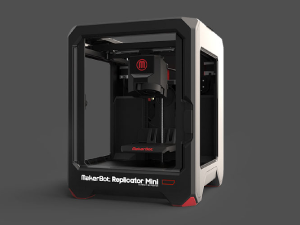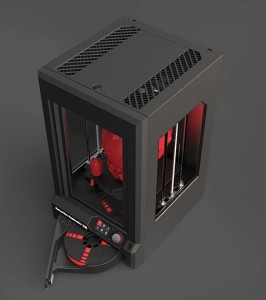Makerbot brings 3D Printing to the Public
Makerbot, one of the world’s biggest manufacterers of consumer 3D Printers, has unveiled several new printers with built-in cameras. With prices starting in the mid-thousand, will this be the combination that will bring 3D printing to the public?
The base model is the Replicator Mini. Makerbot emphasizes its user friendliness, and that it is about half the size of the original model. A well-heard argument against buying a printer because of lack of space should therefore become much less an issue.

The Mini can be controlled by a computer or through an app, over wifi or usb. “There’s only one button on the device”, said Makerbot CEO Bre Pettis during the press conference on the CES gadget fair in Las Vegas.
The easy-to-use, no-compromise
compact 3D printer for everyone,
from beginners to professionals. – Makerbot Mini
“If I was presenting a camera, it would be a point-and-shoot type.” The Replicator has a camera inside the printing chamber that measures and shares the progress of the print. The Replicator Mini will be on sale in the U.S. in Spring, for a price tag of $1375. Still too much? Check out the RepRap.
Makerbot Replicator
The bigger Replicator models are also getting an update. The new Replicator is more focused on the professional user, offering more options and possibilities.
Printed objects can now be 11% larger than the Replicator 2 would allow. The highest resolution for Makerbot’s mid-range product is 100 micron. The device carries a 3.5 inch display through which the user can operate the machine, using a turn knob to scroll through the menus. The display also shows how long it takes for the print to finish.
The Replicator can be connected to a network using an ethernet cable, so different computers can send print assignments. Similar to the Replicator Mini there’s a camera onboard. The Replicator can be ordered today for $2899, and will be delivered in February.
Z18
Makerbot also introduced the Replicator Z18, an extra-large 3D printer. Pettis showed a helmet that he had printed with the device, and put it on his head. The larger the size, the more possibilities.

The Z18 is most of all a lot higher. The machine is able to print 12.0 L x 12.0 W x 18.0 H IN objects. You can also print different objects next to eachother, at the same time. Another cool (well actually not) feature is that the air in the print chamber is warmed, offering more stability in printing.
App
Makerbot also introduced a desktop app, offering direct access to the Thingiverse database filled with 3D objects, ready for download. You can control the printer from inside the app, too. The app comes for Windows, Mac and Linux. The earlier versions of the Replicator are also compatible with the app.
Another newcomer is the mobile app, through which you can login to the camera and see the print being made. Awesome! If you want you can also receive a push notification when the print is done. Expect the iOS app in Fall, the Android app following in a later stage.
For tablets users, Makerbot will make an app that enables them to design objects. Again, the company emphasizes the user friendliness of the process. For instance, you can make name signs just by typing. Or how about a bracelet made in a minute? The app is available for iOS in Spring, Android following later.
Store
Makerbot also unveiled their online store, where users can download designs made by Makerbot itself. The models are tested and should be printed without a hassle by Makerbot 3D printers. Designs that you find on Thingiverse can sometimes cause a problem for a specific printer, through the difference of each manufacterers approach. A series of 6 collections of objects will be released, including rockets, dragons and trucks.
Does the introduction of Makerbot’s new products make a change in the way you think of (buying) 3D printers, or is there another aspect 3D printing companies should have to look into?

